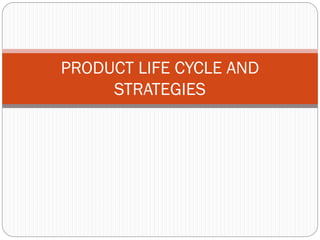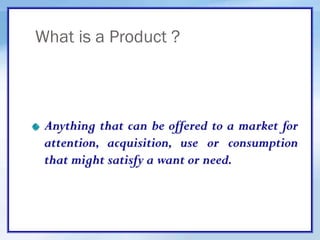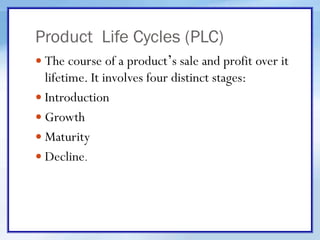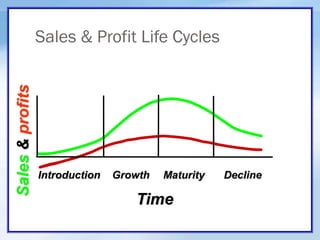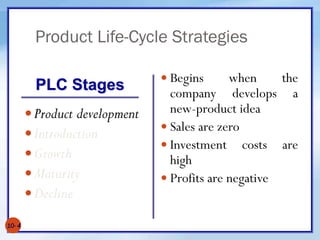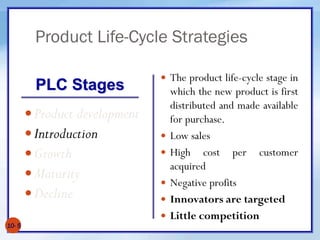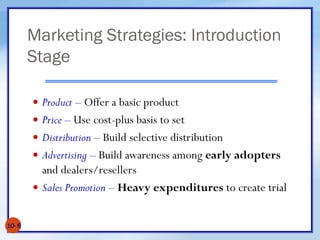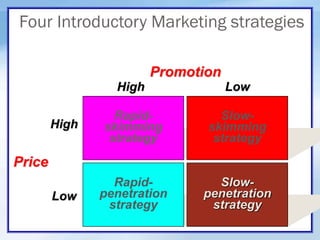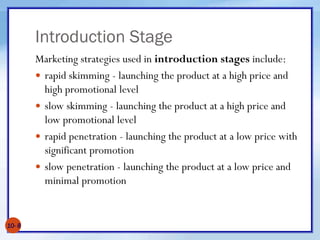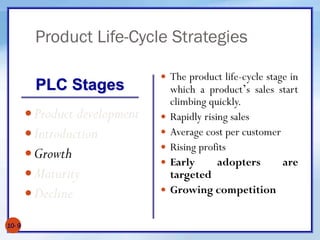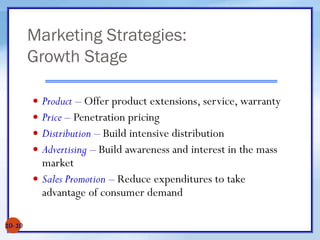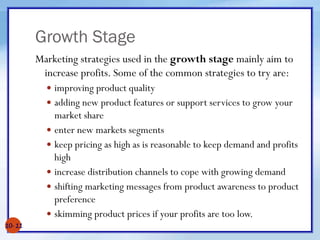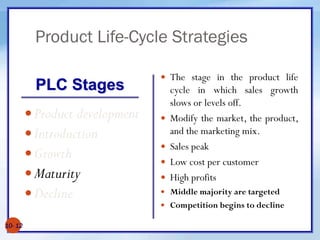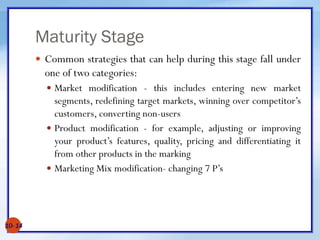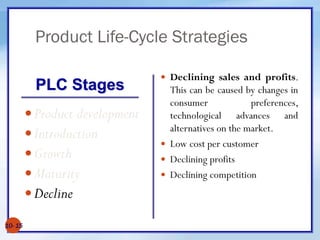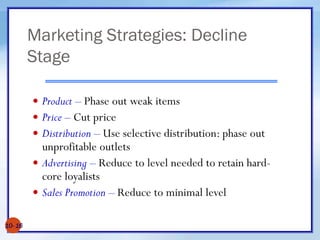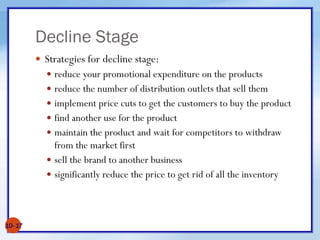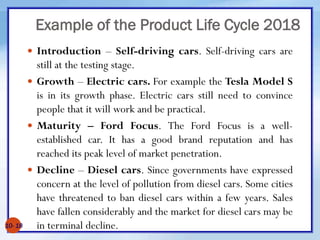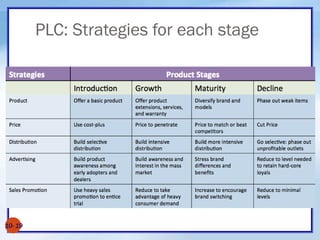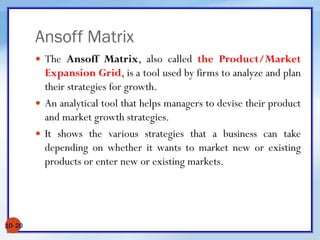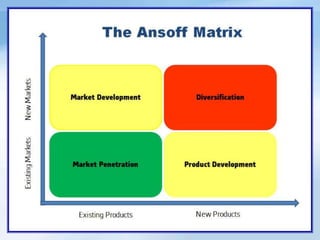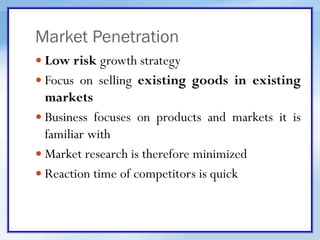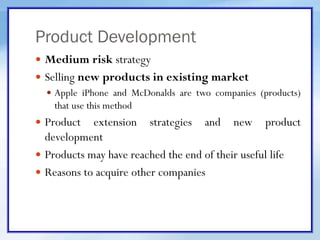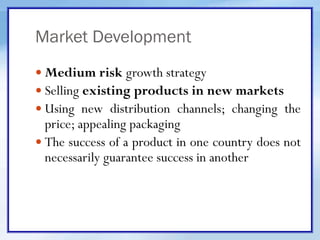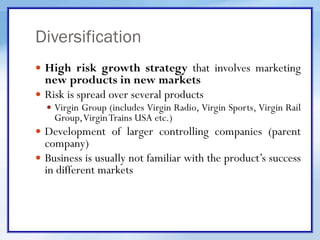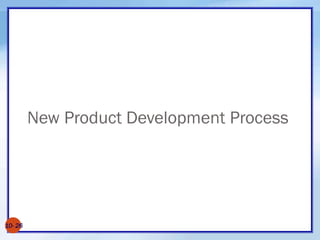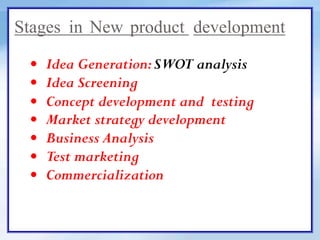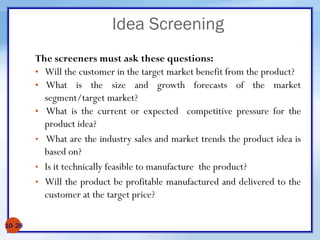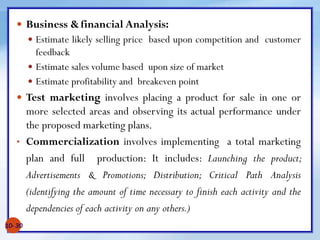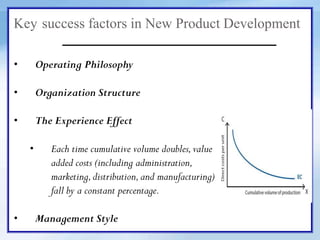Product Life Cycle.ppt
- 1. PRODUCT LIFE CYCLE AND STRATEGIES
- 2. What is a Product ? Anything that can be offered to a market for attention, acquisition, use or consumption that might satisfy a want or need.
- 3. Product Life Cycles (PLC)  The course of a product’s sale and profit over it lifetime. It involves four distinct stages:  Introduction  Growth  Maturity  Decline.
- 4. Sales & Profit Life Cycles Introduction Growth Maturity Decline Time Sales & profits
- 5. Product Life-Cycle Strategies 10- 4 ď‚—Product development ď‚—Introduction ď‚—Growth ď‚—Maturity ď‚—Decline ď‚— Begins when the company develops a new-product idea ď‚— Sales are zero ď‚— Investment costs are high ď‚— Profits are negative PLC Stages
- 6. Product Life-Cycle Strategies 10- 5 ď‚—Product development ď‚—Introduction ď‚—Growth ď‚—Maturity ď‚—Decline ď‚— The product life-cycle stage in which the new product is first distributed and made available for purchase. ď‚— Low sales ď‚— High cost per customer acquired ď‚— Negative profits ď‚— Innovators are targeted ď‚— Little competition PLC Stages
- 7. Marketing Strategies: Introduction Stage 10- 6  Product – Offer a basic product  Price – Use cost-plus basis to set  Distribution – Build selective distribution  Advertising – Build awareness among early adopters and dealers/resellers  Sales Promotion – Heavy expenditures to create trial
- 8. Four Introductory Marketing strategies Rapid- skimming strategy Rapid- penetration strategy Slow- penetration strategy Slow- skimming strategy Price Low High Promotion High Low
- 9. Introduction Stage Marketing strategies used in introduction stages include: ď‚— rapid skimming - launching the product at a high price and high promotional level ď‚— slow skimming - launching the product at a high price and low promotional level ď‚— rapid penetration - launching the product at a low price with significant promotion ď‚— slow penetration - launching the product at a low price and minimal promotion 10- 8
- 10. Product Life-Cycle Strategies 10- 9 Product development Introduction Growth Maturity Decline  The product life-cycle stage in which a product’s sales start climbing quickly.  Rapidly rising sales  Average cost per customer  Rising profits  Early adopters are targeted  Growing competition PLC Stages
- 11. Marketing Strategies: Growth Stage 10- 10  Product – Offer product extensions, service, warranty  Price – Penetration pricing  Distribution – Build intensive distribution  Advertising – Build awareness and interest in the mass market  Sales Promotion – Reduce expenditures to take advantage of consumer demand
- 12. Growth Stage Marketing strategies used in the growth stage mainly aim to increase profits. Some of the common strategies to try are: ď‚— improving product quality ď‚— adding new product features or support services to grow your market share ď‚— enter new markets segments ď‚— keep pricing as high as is reasonable to keep demand and profits high ď‚— increase distribution channels to cope with growing demand ď‚— shifting marketing messages from product awareness to product preference ď‚— skimming product prices if your profits are too low. 10- 11
- 13. Product Life-Cycle Strategies 10- 12 ď‚—Product development ď‚—Introduction ď‚—Growth ď‚—Maturity ď‚—Decline ď‚— The stage in the product life cycle in which sales growth slows or levels off. ď‚— Modify the market, the product, and the marketing mix. ď‚— Sales peak ď‚— Low cost per customer ď‚— High profits ď‚— Middle majority are targeted ď‚— Competition begins to decline PLC Stages
- 14. Marketing Strategies: Maturity Stage 10- 13  Product – Diversify brand and models  Price – Set to match or beat competition  Distribution – Build more intensive distribution  Advertising – Stress brand differences and benefits  Sales Promotion – Increase to encourage brand switching
- 15. Maturity Stage  Common strategies that can help during this stage fall under one of two categories:  Market modification - this includes entering new market segments, redefining target markets, winning over competitor’s customers, converting non-users  Product modification - for example, adjusting or improving your product’s features, quality, pricing and differentiating it from other products in the marking  Marketing Mix modification- changing 7 P’s 10- 14
- 16. Product Life-Cycle Strategies 10- 15 ď‚—Product development ď‚—Introduction ď‚—Growth ď‚—Maturity ď‚—Decline ď‚— Declining sales and profits. This can be caused by changes in consumer preferences, technological advances and alternatives on the market. ď‚— Low cost per customer ď‚— Declining profits ď‚— Declining competition PLC Stages
- 17. Marketing Strategies: Decline Stage 10- 16  Product – Phase out weak items  Price – Cut price  Distribution – Use selective distribution: phase out unprofitable outlets  Advertising – Reduce to level needed to retain hard- core loyalists  Sales Promotion – Reduce to minimal level
- 18. Decline Stage ď‚— Strategies for decline stage: ď‚— reduce your promotional expenditure on the products ď‚— reduce the number of distribution outlets that sell them ď‚— implement price cuts to get the customers to buy the product ď‚— find another use for the product ď‚— maintain the product and wait for competitors to withdraw from the market first ď‚— sell the brand to another business ď‚— significantly reduce the price to get rid of all the inventory 10- 17
- 19. Example of the Product Life Cycle 2018  Introduction – Self-driving cars. Self-driving cars are still at the testing stage.  Growth – Electric cars. For example the Tesla Model S is in its growth phase. Electric cars still need to convince people that it will work and be practical.  Maturity – Ford Focus. The Ford Focus is a well- established car. It has a good brand reputation and has reached its peak level of market penetration.  Decline – Diesel cars. Since governments have expressed concern at the level of pollution from diesel cars. Some cities have threatened to ban diesel cars within a few years. Sales have fallen considerably and the market for diesel cars may be in terminal decline. 10- 18
- 20. PLC: Strategies for each stage 10- 19
- 21. Ansoff Matrix 10- 20 ď‚— The Ansoff Matrix, also called the Product/Market Expansion Grid, is a tool used by firms to analyze and plan their strategies for growth. ď‚— An analytical tool that helps managers to devise their product and market growth strategies. ď‚— It shows the various strategies that a business can take depending on whether it wants to market new or existing products or enter new or existing markets.
- 23. Market Penetration ď‚— Low risk growth strategy ď‚— Focus on selling existing goods in existing markets ď‚— Business focuses on products and markets it is familiar with ď‚— Market research is therefore minimized ď‚— Reaction time of competitors is quick
- 24. Product Development ď‚— Medium risk strategy ď‚— Selling new products in existing market ď‚— Apple iPhone and McDonalds are two companies (products) that use this method ď‚— Product extension strategies and new product development ď‚— Products may have reached the end of their useful life ď‚— Reasons to acquire other companies
- 25. Market Development ď‚— Medium risk growth strategy ď‚— Selling existing products in new markets ď‚— Using new distribution channels; changing the price; appealing packaging ď‚— The success of a product in one country does not necessarily guarantee success in another
- 26. Diversification  High risk growth strategy that involves marketing new products in new markets  Risk is spread over several products  Virgin Group (includes Virgin Radio, Virgin Sports, Virgin Rail Group,VirginTrains USA etc.)  Development of larger controlling companies (parent company)  Business is usually not familiar with the product’s success in different markets
- 27. New Product Development Process 10- 26
- 28. Stages in New product development ď‚— Idea Generation:SWOT analysis ď‚— Idea Screening ď‚— Concept development and testing ď‚— Market strategy development ď‚— Business Analysis ď‚— Test marketing ď‚— Commercialization
- 29. Idea Screening The screeners must ask these questions: • Will the customer in the target market benefit from the product? • What is the size and growth forecasts of the market segment/target market? • What is the current or expected competitive pressure for the product idea? • What are the industry sales and market trends the product idea is based on? • Is it technically feasible to manufacture the product? • Will the product be profitable manufactured and delivered to the customer at the target price? 10- 28
- 30.  Concept Testing presents the consumer with a proposed product and measure attitudes and intention at this early stage of development.  Market Strategy Development: Includes development of three part strategy plan  Describe the market’s size, structure, and behaviour, the planned product positioning, and the sales, market share, and profit goals for first few years.  Outlines the planned price, distribution strategy, and marketing budget for the first year.  Describes the long-run sales and profit goals and marketing- mix strategy over time. 10- 29
- 31.  Business &financial Analysis:  Estimate likely selling price based upon competition and customer feedback  Estimate sales volume based upon size of market  Estimate profitability and breakeven point  Test marketing involves placing a product for sale in one or more selected areas and observing its actual performance under the proposed marketing plans. • Commercialization involves implementing a total marketing plan and full production: It includes: Launching the product; Advertisements & Promotions; Distribution; Critical Path Analysis (identifying the amount of time necessary to finish each activity and the dependencies of each activity on any others.) 10- 30
- 32. Key success factors in New Product Development • Operating Philosophy • Organization Structure • The Experience Effect • Each time cumulative volume doubles,value added costs (including administration, marketing,distribution,and manufacturing) fall by a constant percentage. • Management Style
